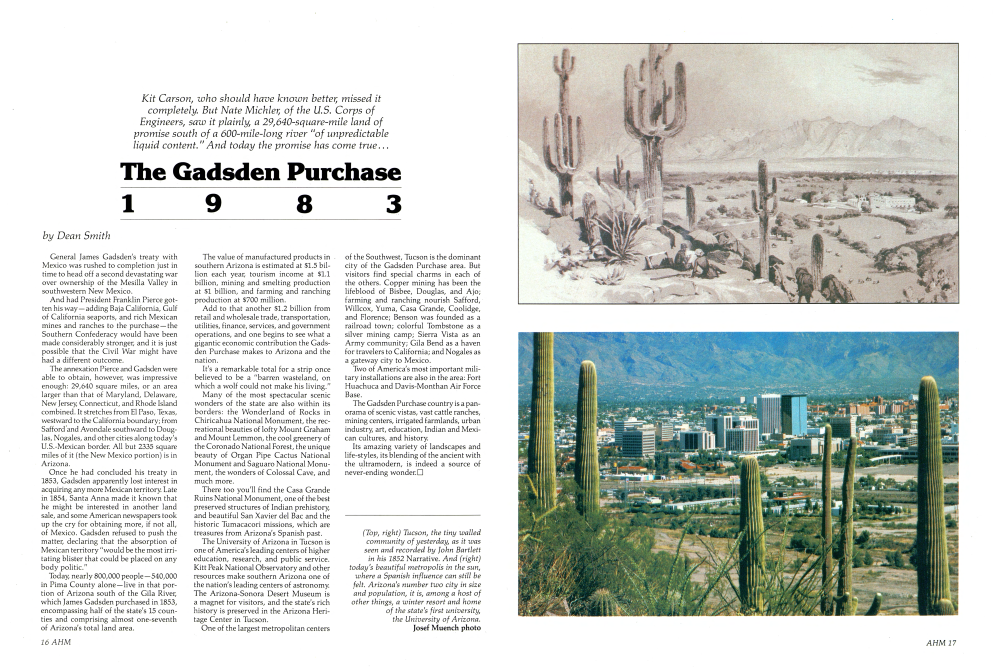The Gadsden Purchase-1983

Kit Carson, who should have known better, missed it completely. But Nate Michler, of the U.S. Corps of Engineers, saw it plainly, a 29,640-square-mile land of promise south of a 600-mile-long river "of unpredictable liquid content." And today the promise has come true...
The Gadsden Purchase
by Dean Smith General James Gadsden's treaty with Mexico was rushed to completion just in time to head off a second devastating war over ownership of the Mesilla Valley in southwestern New Mexico. And had President Franklin Pierce gotten his way-adding Baja California, Gulf of California seaports, and rich Mexican mines and ranches to the purchase-the Southern Confederacy would have been made considerably stronger, and it is just possible that the Civil War might have had a different outcome.
The annexation Pierce and Gadsden were able to obtain, however, was impressive enough: 29,640 square miles, or an area larger than that of Maryland, Delaware, New Jersey, Connecticut, and Rhode Island combined. It stretches from El Paso, Texas, westward to the California boundary; from Safford and Avondale southward to Douglas, Nogales, and other cities along today's U.S.-Mexican border. All but 2335 square miles of it (the New Mexico portion) is in Arizona.
Once he had concluded his treaty in 1853, Gadsden apparently lost interest in acquiring any more Mexican territory. Late in 1854, Santa Anna made it known that he might be interested in another land sale, and some American newspapers took up the cry for obtaining more, if not all, of Mexico. Gadsden refused to push the matter, declaring that the absorption of Mexican territory "would be the most irriStating blister that could be placed on any body politic."
The value of manufactured products in southern Arizona is estimated at $1.5 billion each year, tourism income at $1.1 billion, mining and smelting production at $1 billion, and farming and ranching production at $700 million.
Add to that another $1.2 billion from retail and wholesale trade, transportation, utilities, finance, services, and government operations, and one begins to see what a gigantic economic contribution the Gadsden Purchase makes to Arizona and the nation.
It's a remarkable total for a strip once believed to be a "barren wasteland, on which a wolf could not make his living."
Many of the most spectacular scenic wonders of the state are also within its borders: the Wonderland of Rocks in Chiricahua National Monument, the recreational beauties of lofty Mount Graham and Mount Lemmon, the cool greenery of the Coronado National Forest, the unique beauty of Organ Pipe Cactus National Monument and Saguaro National Monument, the wonders of Colossal Cave, and much more.
There too you'll find the Casa Grande Ruins National Monument, one of the best preserved structures of Indian prehistory, and beautiful San Xavier del Bac and the historic Tumacacori missions, which are treasures from Arizona's Spanish past.
The University of Arizona in Tucson is one of America's leading centers of higher education, research, and public service. Kitt Peak National Observatory and other resources make southern Arizona one of the nation's leading centers of astronomy.
The Arizona-Sonora Desert Museum is a magnet for visitors, and the state's rich history is preserved in the Arizona Heritage Center in Tucson.
One of the largest metropolitan centers of the Southwest, Tucson is the dominant city of the Gadsden Purchase area. But visitors find special charms in each of the others. Copper mining has been the lifeblood of Bisbee, Douglas, and Ajo; Farming and ranching nourish Safford, Willcox, Yuma, Casa Grande, Coolidge, and Florence; Benson was founded as a railroad town; colorful Tombstone as a silver mining camp; Sierra Vista as an Army community; Gila Bend as a haven for travelers to California; and Nogales as a gateway city to Mexico.
Two of America's most important military installations are also in the area: Fort Huachuca and Davis-Monthan Air Force Base.
The Gadsden Purchase country is a panorama of scenic vistas, vast cattle ranches, mining centers, irrigated farmlands, urban industry, art, education, Indian and Mexican cultures, and history.
Its amazing variety of landscapes and life-styles, its blending of the ancient with the ultramodern, is indeed a source of never-ending wonder (Top, right) Tucson, the tiny walled community of yesterday, as it was seen and recorded by John Bartlett in his 1852 Narrative. And (right) today's beautiful metropolis in the sun, where a Spanish influence can still be felt. Arizona's number two city in size and population, it is, among a host of other things, a winter resort and home of the state's first university, the University of Arizona.
Already a member? Login ».